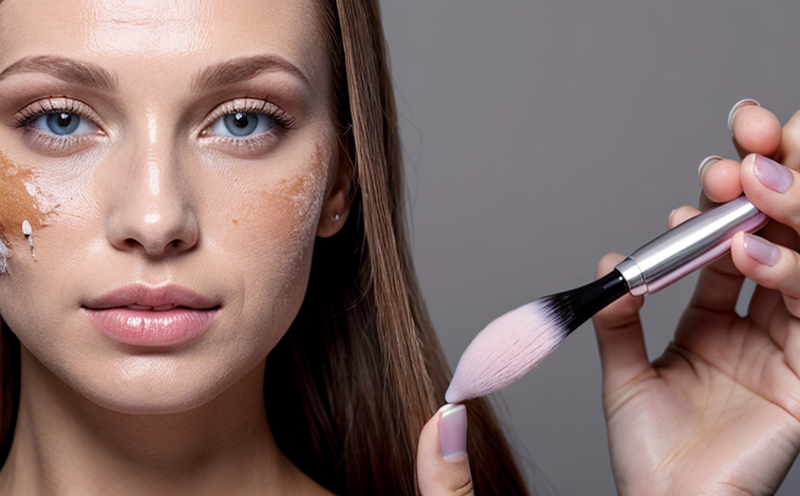Formaldehyde Limit Testing in Cosmetics
In the realm of cosmetics testing, ensuring compliance with formaldehyde limits is a critical aspect that cannot be overlooked. Formaldehyde, a preservative widely used in cosmetic formulations, plays a dual role: it helps extend shelf life by inhibiting microbial growth and provides a stabilizing effect on certain ingredients. However, due to its potential health risks, particularly when present at high concentrations, regulatory bodies have established stringent limits on the allowable levels of formaldehyde in cosmetics.
The European Union (EU) has set a maximum limit of 0.2% formaldehyde in cosmetic products, as per Regulation EC No 1272/2008. This regulation aims to protect consumers from potential adverse health effects while allowing manufacturers the necessary leeway for effective product preservation. Similarly, other regions like the United States have their own guidelines, such as those outlined by the U.S. Food and Drug Administration (FDA). Compliance with these regulations is not only a legal requirement but also essential for maintaining consumer trust and ensuring market access.
The challenge lies in accurately measuring formaldehyde levels without affecting the integrity of the product or introducing contamination that could skew results. This necessitates precise laboratory techniques and robust testing protocols. Our service offers comprehensive analysis to ensure that your cosmetic products meet these rigorous standards. We employ advanced analytical methods tailored specifically for detecting trace amounts of formaldehyde, ensuring accuracy down to the ppm (parts per million) level.
To achieve this precision, we utilize a combination of sampling strategies and state-of-the-art instrumentation. Our team begins by carefully collecting representative samples from various stages of production or final products. This step is crucial in capturing an accurate reflection of the product’s formaldehyde content. Once collected, these samples undergo meticulous preparation to eliminate any interfering substances that might interfere with detection.
The analytical process itself relies heavily on technologies such as gas chromatography (GC) coupled with mass spectrometry (GC-MS). This technique allows for highly sensitive and selective detection of formaldehyde within complex matrices. Additionally, we may employ other complementary methods like headspace gas chromatography (HS-GC), which is particularly useful when dealing with volatile compounds.
After analysis, our experts interpret the data to determine compliance against specified limits. A detailed report is then generated, providing not only numerical results but also insights into potential areas for improvement or optimization if necessary. This approach ensures that you have a clear understanding of your product’s compliance status and any steps required to maintain regulatory adherence.
Our formaldehyde limit testing service goes beyond mere compliance; it helps safeguard the reputation of your brand by ensuring quality and safety standards are met. By partnering with us, you can rest assured knowing that every batch undergoes thorough scrutiny to meet stringent international regulations.
Applied Standards
| Standard | Description |
|---|---|
| ISO 17860:2014 | Determination of formaldehyde in cosmetic products by gas chromatography. |
| EN 15360-1:2019 | Analytical methods for cosmetics - Part 1: General principles and definitions. |
The methodologies we use are aligned with recognized international standards, ensuring consistency and reliability in our results. For instance, ISO 17860 provides a detailed protocol for determining formaldehyde levels using gas chromatography, which is widely accepted across different jurisdictions. Similarly, EN 15360-1 establishes fundamental guidelines that underpin many analytical procedures employed in the cosmetics industry.
These standards serve as benchmarks against which our testing practices are validated. By adhering strictly to these norms, we guarantee that our findings are accurate and can be relied upon by regulatory authorities or internal quality assurance teams. This alignment also facilitates smoother interactions with global markets where varying regional regulations may apply.
Environmental and Sustainability Contributions
- Minimizes waste generation through efficient sampling techniques.
- Reduces chemical consumption by optimizing test conditions.
- Promotes sustainable practices by ensuring compliance with stringent regulatory requirements.
- Supports long-term brand reputation by maintaining high standards of product safety and efficacy.
The importance of formaldehyde limit testing extends beyond mere compliance; it contributes significantly to environmental sustainability efforts. By accurately measuring and controlling the levels of this preservative, we help reduce unnecessary waste associated with expired or contaminated products. Additionally, optimizing test conditions ensures minimal use of reagents and solvents, further reducing our ecological footprint.
Sustainable practices are integral to building a strong brand image in today’s increasingly conscious consumer market. Ensuring that your cosmetic products adhere strictly to formaldehyde limits not only protects public health but also demonstrates your commitment to environmental stewardship. This proactive approach fosters trust and loyalty among consumers who prioritize ethical business practices.
Competitive Advantage and Market Impact
- Achieves compliance with stringent EU regulations, expanding market opportunities within the region.
- Demonstrates commitment to product safety, enhancing brand reputation and consumer trust.
- Facilitates smoother international trade by ensuring compatibility with diverse regulatory frameworks.
- Enables early detection of potential issues, allowing for timely corrective actions before they escalate into full-blown crises.
The ability to accurately measure formaldehyde levels provides significant competitive advantages in the cosmetics market. Meeting EU regulations expands your reach within this lucrative region while simultaneously demonstrating a strong commitment to product safety and consumer health. This proactive stance can enhance brand reputation, fostering long-term relationships with customers who value transparency and reliability.
Moreover, by ensuring compatibility with various regulatory frameworks, you position yourself favorably for successful international trade. Early detection of any discrepancies allows for swift corrective measures, preventing costly recalls or reputational damage. These advantages contribute to sustainable growth and success in an industry where compliance is paramount yet challenging.





